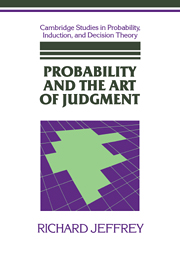Book contents
- Frontmatter
- Contents
- Preface
- 1 Introduction: Radical probabilism (1991)
- 2 Valuation and acceptance of scientific hypotheses (1956)
- 3 Probable knowledge (1968)
- 4 Probability and the art of judgment (1985)
- 5 Bayesianism with a human face (1983)
- 6 Alias Smith and Jones: The testimony of the senses (1987)
- 7 Conditioning, kinematics, and exchangeability (1988)
- 8 Preference among preferences (1974)
- 9 On interpersonal utility theory (1971)
- 10 Remarks on interpersonal utility theory (1974)
- 11 Mises redux (1977)
- 12 Statistical explanation vs. statistical inference (1969)
- 13 New foundations for Bayesian decision theory (1965)
- 14 Frameworks for preference (1974)
- 15 Axiomatizing the logic of decision (1978)
- 16 A note on the kinematics of preference (1977)
11 - Mises redux (1977)
Published online by Cambridge University Press: 05 June 2012
- Frontmatter
- Contents
- Preface
- 1 Introduction: Radical probabilism (1991)
- 2 Valuation and acceptance of scientific hypotheses (1956)
- 3 Probable knowledge (1968)
- 4 Probability and the art of judgment (1985)
- 5 Bayesianism with a human face (1983)
- 6 Alias Smith and Jones: The testimony of the senses (1987)
- 7 Conditioning, kinematics, and exchangeability (1988)
- 8 Preference among preferences (1974)
- 9 On interpersonal utility theory (1971)
- 10 Remarks on interpersonal utility theory (1974)
- 11 Mises redux (1977)
- 12 Statistical explanation vs. statistical inference (1969)
- 13 New foundations for Bayesian decision theory (1965)
- 14 Frameworks for preference (1974)
- 15 Axiomatizing the logic of decision (1978)
- 16 A note on the kinematics of preference (1977)
Summary
Once one has clarified the concept of random sequence, one can define the probability of an event as the limit of the relative frequency with which this event occurs in the random sequence. This concept of probability then has a well defined physical interpretation.
(Schnorr, 1971, pp. 8–9)Mises' (1919) concept of irregular (“random”) sequence resisted precise mathematical definition for over four decades. (See Martin-Löf, 1970, for some details.) This circumstance led many to see the difficulty of defining “irregular” as the obstacle to success of Mises' program, and to suppose that the solution of that difficulty in recent years has finally set probability theory on the sure path of a science along lines that Mises had envisaged. To the contrary, I shall argue that since stochastic processes do not go on forever, Mises' identification of each such process with the infinite sequence of outputs it would produce if it ran forever is a metaphysical conceit that provides no physical interpretation of probability.
BERNOULLI TRIALS
Martin-Löf (1966) showed how to overcome the distracting technical obstacle to Mises' program, and Schnorr (1971) and others have continued his work. The air is clear for examination of the substantive claim that probabilities can be interpreted in physical terms as limiting relative frequencies of attributes in particular infinite sequences of events.
The simplest examples are provided by binary stochastic processes such as coin-tossing.
- Type
- Chapter
- Information
- Probability and the Art of Judgment , pp. 192 - 202Publisher: Cambridge University PressPrint publication year: 1992
- 4
- Cited by

